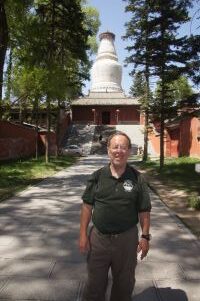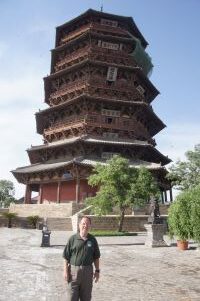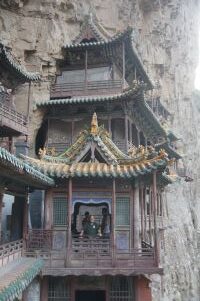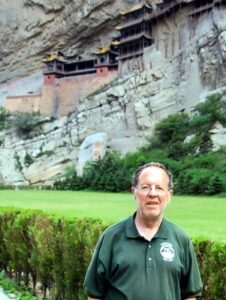Words failed Li Bing when he saw the last temple I saw today. The famous Tang poet could only inscribe “magnificent” on a rock, but added a dot after zhuang guan, an exclamation point in a language that has none.
He might have been thinking about the kind of day I had, which began when we left Pingyao for the 250 or so mile trip to Datong, one that was literally a high (8,000 feet). The first stop should have been the clue—one of the four sacred Buddhist mountains: Wutaishan rises to 2100 meters and has five peaks (hence the name; wu means five). Here’s what I remember:
 -The first temple (we visited it) began shortly after the introduction of Buddhism into China from India, around 70 A.D. Subsequent temples pushed the total up into the hundreds, though today there are only 47. To see them all, my guide suggested, would take half a month.
-The first temple (we visited it) began shortly after the introduction of Buddhism into China from India, around 70 A.D. Subsequent temples pushed the total up into the hundreds, though today there are only 47. To see them all, my guide suggested, would take half a month.
-“base camp” is over a mile high, providing a cool environment in the summer.
 -one of the temples has a white dagoba, an Indian-shaped pagoda that looks something like a bowling pin. Reputedly, it is the largest in China. The signpost said that it was originally built with the help of the great Indian King, Asoka, but I don’t think the timing works. It was enlarged later, and is reputed to hold relics of the Lord Buddha.
-one of the temples has a white dagoba, an Indian-shaped pagoda that looks something like a bowling pin. Reputedly, it is the largest in China. The signpost said that it was originally built with the help of the great Indian King, Asoka, but I don’t think the timing works. It was enlarged later, and is reputed to hold relics of the Lord Buddha.
-a temple built in 1921 has the largest marble arch in China. (everything is largest something or another)

-with the eminent Buddhists of the Qing dynasty claiming to have been descended from the Buddha disciple Manjuri (based on the similarity in the pronunciation of the Manchus), they took a fondness to the site because the temples are dedicated to Manjuri (from what my guide said, each of the famous Buddhist mountains is dedicated to one of the major Bodhisattvas). And given the fondness of the Qing for the Tibetan Lama Buddhism, it  is no surprise that the temples have a lama orientation, some markedly so.
is no surprise that the temples have a lama orientation, some markedly so.
The one we visited had been sequestered by Kangxi, who came five times, and because he turned it into a royal temple, it has a gold roof, and the largest wooden archway in Wutaishan. It also has 108 stairs, which is a solemn number in Buddhism, and a good number for me, because we were going down it. There were a number of steles with poetry or inscriptions by Kangxi and Qianlong, who seemed to have visited a lot of places in their 120 years of rule, and left lots of stone steles.
Our next stop on the ride to Datong was a wooden pagoda, but not just a wooden pagoda—the tallest in China. It dates from the short-lived Liao dynasty (somewhere in the 1100s), and also contains relics (i.e., body pieces) from the Lord Buddha. The Buddha is Liao style—with a green beard and moustache since the Liao, a people from north of the wall (i.e., barbarians) had mustaches, and, therefore, the Buddha would have to as well. Furthermore, the moustache beard was green because the Liao believed green was a sacred color. At least that’s what I was informed. I told you Buddhism allowed local adaptations!
 That the pagoda was in the small town it was because the emperor’s mother came from there, and she was a devout Buddhist. That the pagoda exists is due to its ability to survive two catastrophes in China:
That the pagoda was in the small town it was because the emperor’s mother came from there, and she was a devout Buddhist. That the pagoda exists is due to its ability to survive two catastrophes in China:
1) An earthquake in the late Qing dynasty leveled the rest of the temple, but the tower survived because, being made of wood, it was flexible. As might be expected, a reconstruction of the temple is underway in the name of tourism.
2) The Cultural Revolution. Parts of the Buddha were hacked, and some documents which had been hidden in it were destroyed, including much of the history of the temple.
 The last stop was the one Li Bing, a thousand years ago, called “magnificent “—the hanging temple on Hengshan, another sacred mountain, this one to Daoism. Begun in the Song dynasty (or earlier), the temple looks like it ought to have a frame around it, and be sold as a 3 D insert; it literally clings to the side of a mountain. It was built by monks who perched down from the top, put in beams, carved the caves, etc. It is a Daoist temple—but at least one room helps explain why it (and
The last stop was the one Li Bing, a thousand years ago, called “magnificent “—the hanging temple on Hengshan, another sacred mountain, this one to Daoism. Begun in the Song dynasty (or earlier), the temple looks like it ought to have a frame around it, and be sold as a 3 D insert; it literally clings to the side of a mountain. It was built by monks who perched down from the top, put in beams, carved the caves, etc. It is a Daoist temple—but at least one room helps explain why it (and  not much else on Hengshan) survived the Cultural (and other) Revolution. One multicultural (my word, not the guide’s) room has: the Buddha in the center, one of the Daoist immortals on one side, and Confucius himself on the other. Rumor has it that one tablet was added during the Cultural Revolution—“Long Live Chairman Mao.” And that may well be why the Hanging Temple (truly magnificent, and fortunately, we do have an exclamation point in English!) exists today. Period.
not much else on Hengshan) survived the Cultural (and other) Revolution. One multicultural (my word, not the guide’s) room has: the Buddha in the center, one of the Daoist immortals on one side, and Confucius himself on the other. Rumor has it that one tablet was added during the Cultural Revolution—“Long Live Chairman Mao.” And that may well be why the Hanging Temple (truly magnificent, and fortunately, we do have an exclamation point in English!) exists today. Period.
As I said, a magnificent day.